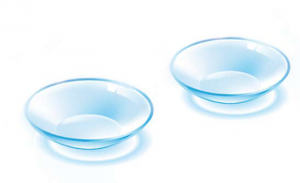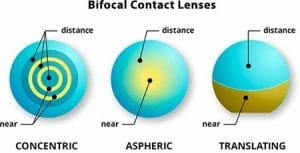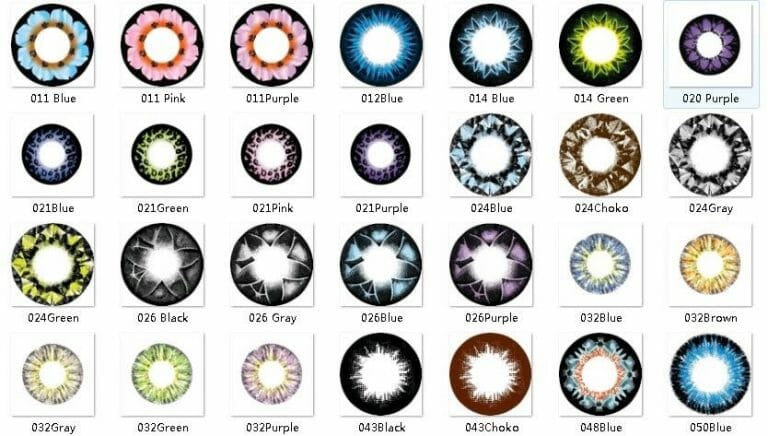Contact lenses are now available in a number of different types of designs that can be used to correct different types of eye problems. There are toric lenses, Spherical lenses, multifocal and bifocal lenses, Monovision, and Orthokeratology.
Toric Contact Lenses:

Toric contact lenses are used to correct astigmatism. These lenses are cylindrical lenses that depend on lid interaction and gravity to rotate to the right angle to correct a bend in the cornea. Normally, the cornea is round but in astigmatism, the cornea curves unevenly in one direction. Toric lenses provide a clear vision to the people with astigmatism as the back of the contact lens perfectly conforms with the curvature of the eye. Also, the surface changes of the lens are not detectable to the person who is wearing the pair.
Toric contact lenses come in either soft or GP lenses and they can have various lens powers to correct astigmatism.
Spherical Lenses:
 These lenses have rounded design which is the most common design. They are used to correct nearsightedness(myopia) or longsightedness (hyperopic). The spherical soft lenses are used to correct nearsightedness and farsightedness while the spherical GP lenses are good for correcting astigmatism as well in addition to farsightedness and nearsightedness.
These lenses have rounded design which is the most common design. They are used to correct nearsightedness(myopia) or longsightedness (hyperopic). The spherical soft lenses are used to correct nearsightedness and farsightedness while the spherical GP lenses are good for correcting astigmatism as well in addition to farsightedness and nearsightedness.
The spherical lenses are deemed to be the safest lenses that imitate the spherical shape of your eyes. They have the same optical power all over the lens, unlike bifocal lenses, multifocal lenses, and toric contact lenses. The major drawback of spherical lenses is that they offer a more distorted image than lenses with aligned ends.
Multifocal and Bifocal Lenses:

These kinds of lenses are made for people with presbyopia. Presbyopia is an eye condition that is related to age in which the natural lens of your eye is unable to focus on near objects. It mostly affects people aged 40 and above. The crystalline lens loses elasticity whose function is to direct light inside the eye. These lenses provide two or more corrections that steadily spread throughout the lens providing corrective refraction for presbyopia.
A bifocal lens is divided into two distinct segments each having different vision power; one for near vision and the other for distance vision. These segments allow you to switch your focus from a distant object to the near ones. Although, the vision might not be clear between these two segments. Bifocal lenses are available in rigid gas permeable as well as in soft hydrogel materials. Multifocal lenses have a blend of a range of powers that provides a crisp, youthful vision. They can be bifocals, trifocals or progressive ones.
Today, a wide variety of creative designs are available in multifocal and bifocal lens technology. Each design of these kinds of lenses is used for different kinds of eyes and eye conditions, so the eye doctor determines which design is best for your unique eye type.
Monovision:
Monovision is another choice for people with presbyopia. The lens of a presbyopic eye cannot adjust to focus on both near and distant objects. Monovision involves using one lens for distant objects and the other for near objects. One eye sees the close-up items better and the other eye sees the far away items better. The brain processes a sharp image by collecting images from two signals. It takes a little time to get used to it i.e 1-2 weeks.
Those who wear long-term contact lens can wear reading glasses over the lenses to have a better vision while doing close-up tasks.
Orthokeratology:
 It is a process that uses specially designed lenses. These are some of the most advanced lenses. They can temporarily adjust the contour of the cornea while sleep which allows the wearers to go lens-free during the day. The reshaping of the cornea can reduce myopia. Orthokeratology lenses are made of rigid gas permeable or GP material.
It is a process that uses specially designed lenses. These are some of the most advanced lenses. They can temporarily adjust the contour of the cornea while sleep which allows the wearers to go lens-free during the day. The reshaping of the cornea can reduce myopia. Orthokeratology lenses are made of rigid gas permeable or GP material.
Other names of Orthokeratology are ortho-k, vision shaping, corneal refractive therapy, and corneal reshaping.
The advanced technology of orthokeratology lenses to correct presbyopia and farsightednes is also available now. Research has revealed that these lenses can slow down the progression of nearsightedness.
Youngsters age 8-12 who have progressive myopia are good candidates for ortho-k lenses. They are also effective on adolescents and adults but they are more suitable for people under 40. Eye practitioners suggest orthokeratology for low to mild myopia.
These lenses are to be worn only at night. In the first two weeks, myopia will be gradually reduced and you have to wear disposable soft lenses in the day since your vision will be changing. After two weeks you can stop using lenses during the day and wear orthokeratology lenses at night only.Be sure to use these lenses in close supervision of your eye doctor and visit him regularly to ensure your eyes are adapting well and are healthy.


